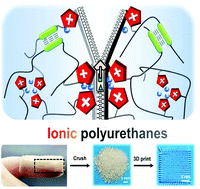Imidazolium-based ionic polyurethanes with high toughness, tunable healing efficiency and antibacterial activities†
Abstract
Imparting synthetic materials with self-healing features is highly desirable for a sustainable future. However, due to the slow diffusion dynamics of polymer chains, it is challenging to fabricate polymers with excellent healing ability while retaining mechanical robustness. In this work, imidazolium-functionalized ionic polyurethanes (PUs) with high toughness, rapid self-healing ability, and antibacterial properties are synthesized. The synergistic effects of hydrogen bonding and reversible ionic interaction between ionic pairs facilitate crack autorepair at mild temperatures (40 °C). The synthesized ionic PUs exhibit high tensile strength (approximately 16.9 MPa), elongation-at-break (approximately 1600%), and toughness (approximately 198 MJ m−3), respectively. Moreover, the antibacterial properties and self-healing nature of ionic PUs can be adjusted by modulating the length of substituted alkyl chains (methyl, butyl or octyl groups) of imidazolium cations. Longer alkyl chain length correlates with higher antibacterial activities and better self-healing behavior. Additionally, the ionic PUs exhibit good shape memory behaviors with rapid shape fixing and recovery rates. Based on these features, the presented copolymers are easily reshaped and offer promise for various applications, such as orthopedic fixation devices.



 Please wait while we load your content...
Please wait while we load your content...